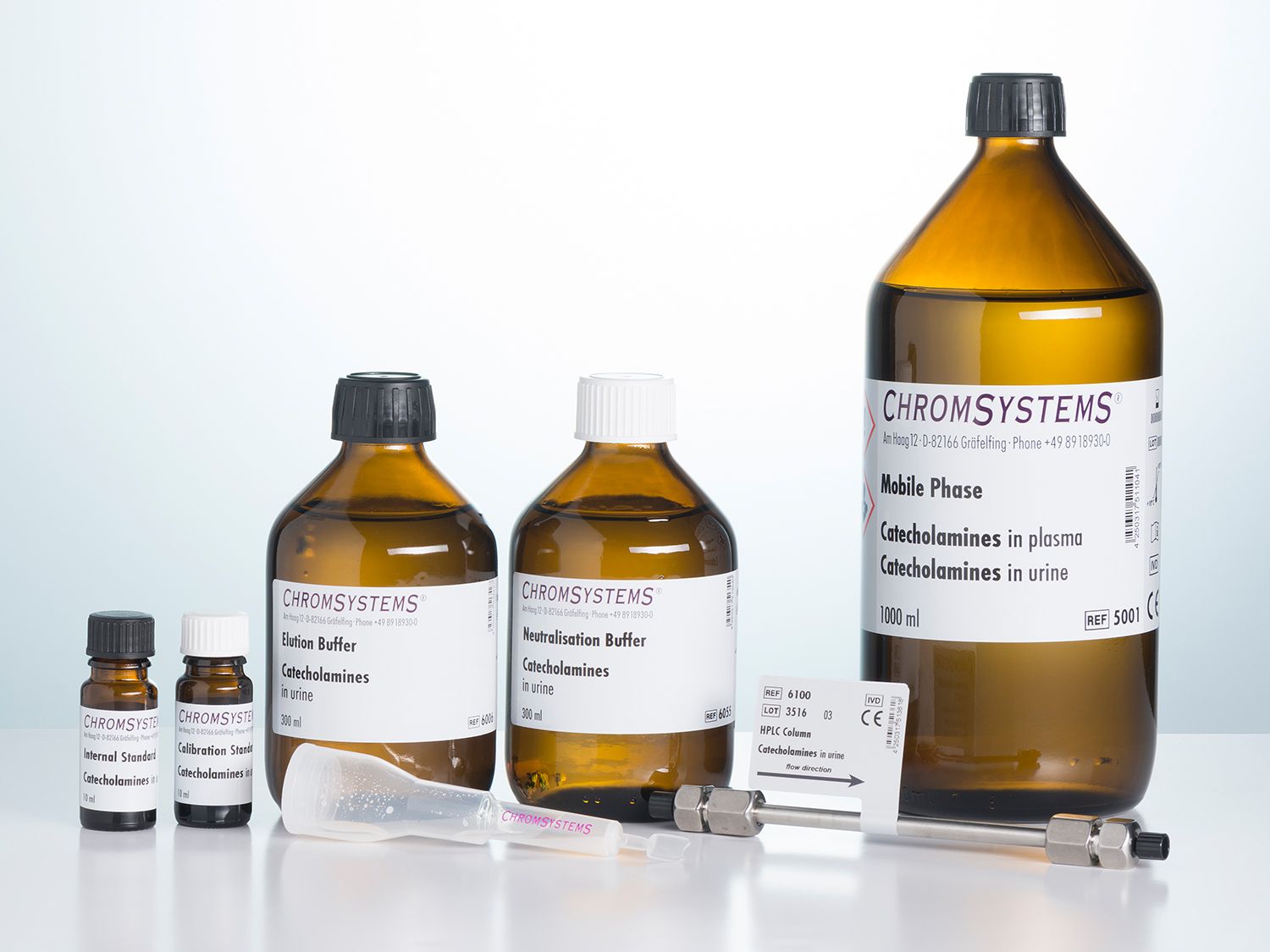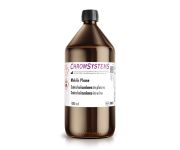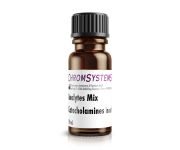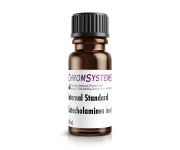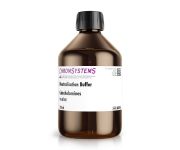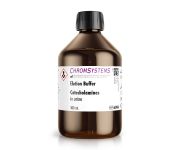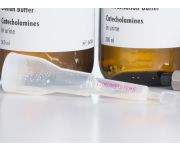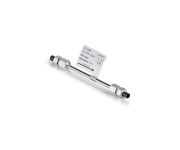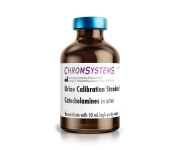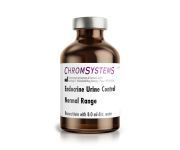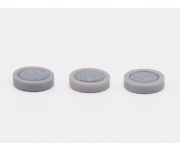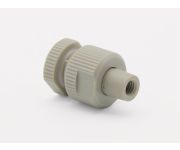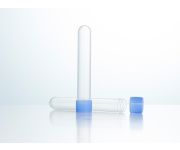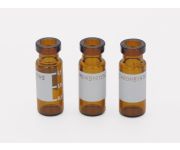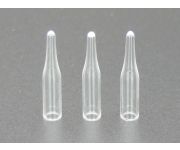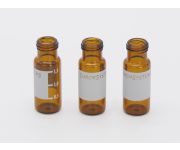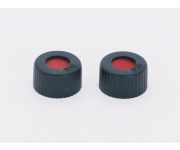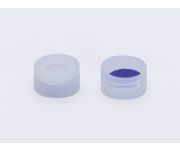Catecholamines in Urine - HPLC
Easy pH adjustment through Neutralisation Buffer with integrated indicator
Assay validated according to IVDR (=> Declaration of Conformity)
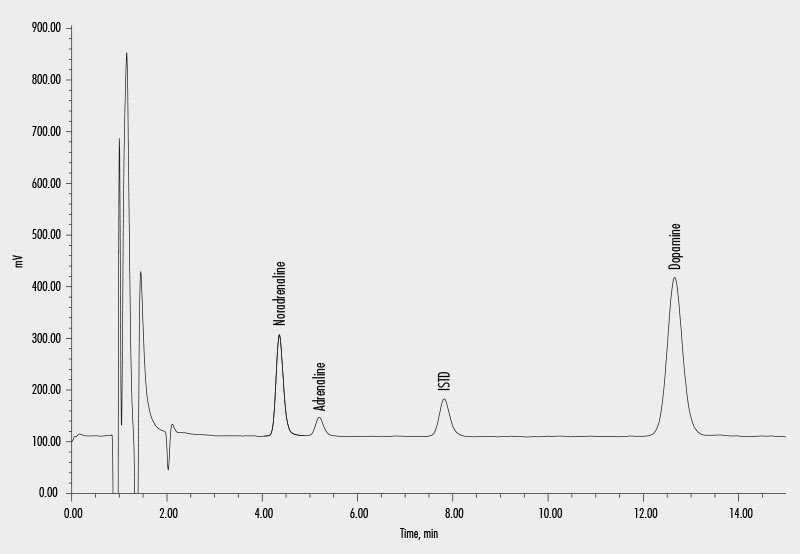

Adrenaline (Epinephrine)
Dopamine
Noradrenaline (Norepinephrine)
Clinical relevance
This Chromsystems assay allows the simultaneous quantitative determination of noradrenaline (syn. norepinephrine), adrenaline (syn. epinephrine), and dopamine in human urine samples by HPLC.
It is intended to be used for patients in whom the urinary levels of noradrenaline, adrenaline and dopamine are of clinical importance, primarily as an aid to diagnosis and monitoring of suspected pheochromocytoma and paraganglioma.
Assay characteristics
Sample preparation consists of an efficient solid-phase extraction. The adjustment of the pH to ensure complete extraction is checked based on the colour change of an indicator. The use of a specific internal standard ensures high precision and reliability in quantitation of the analytes. The analytes and the internal standard are then chromatographically separated in a single isocratic HPLC run and quantified using an electrochemical detector (ECD).
The assays 2020-C and 6000-C are available as alternative methods that allow the combined determination of catecholamines and metanephrine with one column.
There is also a method for the HPLC analysis of catecholamines in plasma available (order no. 5000).
Detailed performance evaluation data can be found in Appendices II and III of the instruction manual.
| Method of Analysis | HPLC |
|---|---|
| Number of Tests | 100 |
| Please note | The information listed here, including the sample preparation, is not sufficient for using the product. Please read the information provided in the instruction manual, which includes detailed information on limitations associated with the use of the product in line with its intended purpose. Detailed performance evaluation data can be found in Appendices II and III of the instruction manual. |
| Lower and Upper Limit of Quantitation | Noradrenaline/Epinephrine: 2.8 µg/L – 1000 µg/L |
| Specimen | 24-hour urine. Alternatively spot urine may also be used. In this case, results must be related to creatinine. |
| Sample Preparation | The information on the sample preparation presented here is not sufficient for use in the laboratory. For a detailed step by step description, please refer to the instruction manual. Buffering and pH-adjustment of sample/calibrator/control
Sample extraction with Sample Clean Up Columns
Continued sample preparation prior to injection
|
| Run Time | 15 min |
| Injection Volume | 20 µL |
| Flow Rate | 1.0 mL/min |
| Column Temperature | +20 to +25 °C |
| Potential | approx. +400 to +500 mV |
| Additional Info | For the HPLC analysis of catecholamines any isocratic HPLC system with electrochemical detector is suitable. |
| Parameters | Adrenaline (Epinephrine), Dopamine, Noradrenaline (Norepinephrine) |


Adrenaline (Epinephrine)
Dopamine
Noradrenaline (Norepinephrine)
Clinical relevance
This Chromsystems assay allows the simultaneous quantitative determination of noradrenaline (syn. norepinephrine), adrenaline (syn. epinephrine), and dopamine in human urine samples by HPLC.
It is intended to be used for patients in whom the urinary levels of noradrenaline, adrenaline and dopamine are of clinical importance, primarily as an aid to diagnosis and monitoring of suspected pheochromocytoma and paraganglioma.
Assay characteristics
Sample preparation consists of an efficient solid-phase extraction. The adjustment of the pH to ensure complete extraction is checked based on the colour change of an indicator. The use of a specific internal standard ensures high precision and reliability in quantitation of the analytes. The analytes and the internal standard are then chromatographically separated in a single isocratic HPLC run and quantified using an electrochemical detector (ECD).
The assays 2020-C and 6000-C are available as alternative methods that allow the combined determination of catecholamines and metanephrine with one column.
There is also a method for the HPLC analysis of catecholamines in plasma available (order no. 5000).
Detailed performance evaluation data can be found in Appendices II and III of the instruction manual.
| Method of Analysis | HPLC |
|---|---|
| Number of Tests | 100 |
| Please note | The information listed here, including the sample preparation, is not sufficient for using the product. Please read the information provided in the instruction manual, which includes detailed information on limitations associated with the use of the product in line with its intended purpose. Detailed performance evaluation data can be found in Appendices II and III of the instruction manual. |
| Lower and Upper Limit of Quantitation | Noradrenaline/Epinephrine: 2.8 µg/L – 1000 µg/L |
| Specimen | 24-hour urine. Alternatively spot urine may also be used. In this case, results must be related to creatinine. |
| Sample Preparation | The information on the sample preparation presented here is not sufficient for use in the laboratory. For a detailed step by step description, please refer to the instruction manual. Buffering and pH-adjustment of sample/calibrator/control
Sample extraction with Sample Clean Up Columns
Continued sample preparation prior to injection
|
| Run Time | 15 min |
| Injection Volume | 20 µL |
| Flow Rate | 1.0 mL/min |
| Column Temperature | +20 to +25 °C |
| Potential | approx. +400 to +500 mV |
| Additional Info | For the HPLC analysis of catecholamines any isocratic HPLC system with electrochemical detector is suitable. |
| Parameters | Adrenaline (Epinephrine), Dopamine, Noradrenaline (Norepinephrine) |

